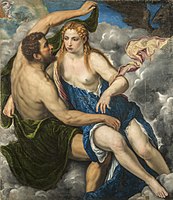art.wikisort.org - Artist
Paris Bordone (Paris Paschalinus Bordone; 5 July 1500 – 19 January 1571) was an Italian painter of the Venetian Renaissance who, despite training with Titian, maintained a strand of Mannerist complexity and provincial vigor.

![Venus and Amor, 1545–1550, imagination of an idealized beauty in the form introduced by Giorgione that once belonged to Adolf Hitler,[1] National Museum in Warsaw](http://upload.wikimedia.org/wikipedia/commons/thumb/c/cf/Bordone_Venus_and_Amor.jpg/220px-Bordone_Venus_and_Amor.jpg)

This article needs additional citations for verification. (March 2015) |

Biography

Bordone was born in Treviso, but had moved to Venice by late adolescence. He apprenticed briefly and unhappily (according to Vasari) with Titian. Vasari may have met the elder Bordone.
Bordone's works of the 1520s include the Holy Family in Florence, Sacra Conversazione with Donor (Glasgow), and Holy Family with St. Catherine (Hermitage Museum). The St. Ambrose and a Donor (1523) is now in the Pinacoteca di Brera. In 1525–26, Bordone painted an altarpiece for the church of S. Agostino in Crema, a Madonna with St. Christopher and St George (now in the Palazzo Tadini collection at Lovere). A second altarpiece, Pentecost, is also in the Pinacoteca di Brera.

In 1534–35, he painted his large-scale masterpiece for the Scuola di San Marco a canvas of The Fisherman Presenting the Ring to Doge Gradenigo (Accademia). However, comparison between this latter painting and the near-contemporary, and structurally similar, Presentation of the Virgin[2] reveals Bordone's limitations, his use of superior perspective which creates dwarfed distant perspectives, and limited coloration relative to the brilliant tints of Titian.
Bordone also painted smaller cabinet pieces, showing half-figures, semi-undressed men and women from mythology or religious stories in a muscular interaction despite the crowded space. He frequently combined portraiture with allegory.[3]
Paris Bordone subsequently executed many important mural paintings in Venice, Treviso and Vicenza, all of which have perished. In 1538 he was invited to France by Francis I, at whose court he painted many portraits, though no trace of them is to be found in French collections, the two portraits at the Louvre being later acquisitions. On his return journey he also worked for the Fugger palace at Augsburg, but again the works have been lost.
Partial list of works
- Annunciation in the Musée des Beaux-Arts de Caen
- Baptism of Christ in the National Gallery of Art, Washington, D.C.
- Bathsheba Bathing, with an African Servant - The Walters Art Museum, Baltimore
- Chess Players in Berlin
- Daphnis and Chloe - Porczyński Gallery, Warsaw
- Holy Family - Bridgewater House, Westminster
- Madonna - Accademia di Belle Arti Tadini at Lovere
- Mythological picture - the Galleria Borghese, Rome
- Mythological picture - the Doria Pamphilj Gallery, Rome
- The paintings in the Duomo of Treviso
- Rest on the Flight into Egypt - National Gallery of Victoria
- Portrait of a young woman - Thyssen-Bornemisza Museum, Madrid
- Perseus Armed by Mercury and Minerva - Birmingham Museum of Art
- A Portrait of a Lady - The National Gallery, London
- Portrait of Giovanni Jacopo Caraglio - Wawel Castle, Kraków
- Jupiter and Io
- Flora
- Alvise Contarini
- The Rest on the Flight into Egypt, c. 1530 (Musée des Beaux-Arts de Strasbourg)
- The Baptism of Christ, c. 1535–1540. National Gallery of Art, Washington, D.C.
- Venus and Mars with Cupid, 1559–1560. Doria Pamphilj Gallery
- The Rape of Proserpina
- Athena Scorning the Advances of Hephaestus
- Venus, Flora, Mars and Cupid (An Allegory), 1550s. The Hermitage Museum.
- Presentation of the Ring to the Doge (Bartolomeo Gradenigo), 1534
- Portrait of a young woman, ca 1543-1550. Thyssen-Bornemisza Museum , Madrid.[4]
References
- Schwarz, Birgit (2009). Geniewahn: Hitler und die Kunst. Böhlau Verlag Wien. p. 312. ISBN 978-32-05783-07-7.
Mehrere Gemälde aus dem Berghof befinden sich heute im Nationalmuseum in Warschau. Bordones Venus und Amor etwa (Abb. 100)
- By Titian and also at Accademia
- Mandel, Corinne (2003). "Bordone [Bordon], Paris". Grove Art Online.
- "Portrait of a Young Woman". Museo Nacional Thyssen-Bornemisza. Retrieved 2022-07-05.
- Attribution
- This article incorporates text from a publication now in the public domain: Chisholm, Hugh, ed. (1911). "Bordone, Paris". Encyclopædia Britannica (11th ed.). Cambridge University Press.
На других языках
[de] Paris Bordone
Paris Bordone, auch Paris Bordon (* um 1500 in Treviso; † 19. Januar 1570 more veneto, also 1571, in Venedig) war ein Maler der venezianischen Schule.- [en] Paris Bordone
[es] Paris Bordone
Paris Bordon o Paris Paschalinus Bordone (Treviso; 5 de julio de 1500 - Venecia; 19 de enero de 1570) fue un pintor manierista italiano, discípulo de Tiziano y que mantuvo en su obra un fina línea entre la complejidad manierista y el vigor provinciano.[fr] Pâris Bordone
Paris Bordone ou Bordon[1] (5 juillet 1500 à Trévise - 19 janvier 1571 à Venise) est un peintre italien de l'école vénitienne.[it] Paris Bordon
Pàris Paschalinus Bordón, o anche Pàris Bordone (Treviso, 5 luglio 1500[1] – Venezia, 19 gennaio 1571), è stato un pittore italiano della Repubblica di Venezia del Rinascimento, che lavorò anche insieme a Tiziano, pur caratterizzandosi per una impostazione più marcatamente manierista e un vigore che lasciava trasparire la sua formazione provinciale.[ru] Бордоне, Парис
Парис Бордоне (итал. Paris Bordone) (1500, крещён 5 июля, Тревизо — 19 января 1570, Венеция) — итальянский художник венецианской школы, представитель маньеризма.Другой контент может иметь иную лицензию. Перед использованием материалов сайта WikiSort.org внимательно изучите правила лицензирования конкретных элементов наполнения сайта.
WikiSort.org - проект по пересортировке и дополнению контента Википедии










![Portrait of a young woman, ca 1543-1550. Thyssen-Bornemisza Museum , Madrid.[4]](http://upload.wikimedia.org/wikipedia/commons/thumb/f/fd/Paris_Bordone_-_Ritratto_di_una_giovane_donna.jpg/165px-Paris_Bordone_-_Ritratto_di_una_giovane_donna.jpg)